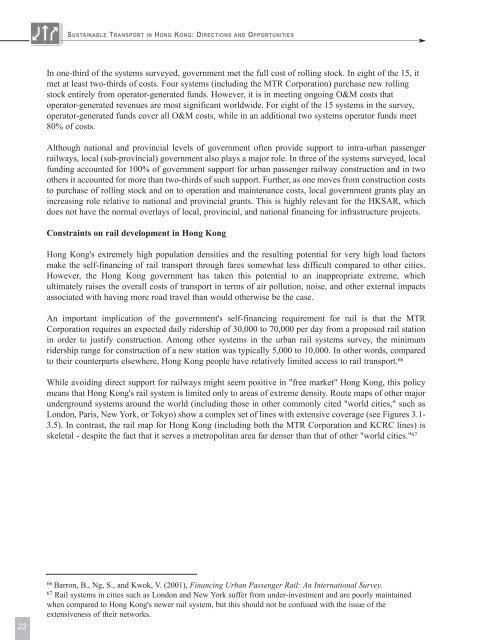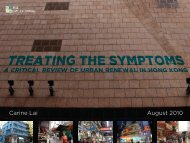Untitled - Civic Exchange
Untitled - Civic Exchange
Untitled - Civic Exchange
Create successful ePaper yourself
Turn your PDF publications into a flip-book with our unique Google optimized e-Paper software.
SUSTAINABLE TRANSPORT IN HONG KONG: DIRECTIONS AND OPPORTUNITIES<br />
In one-third of the systems surveyed, government met the full cost of rolling stock. In eight of the 15, it<br />
met at least two-thirds of costs. Four systems (including the MTR Corporation) purchase new rolling<br />
stock entirely from operator-generated funds. However, it is in meeting ongoing O&M costs that<br />
operator-generated revenues are most significant worldwide. For eight of the 15 systems in the survey,<br />
operator-generated funds cover all O&M costs, while in an additional two systems operator funds meet<br />
80% of costs.<br />
Although national and provincial levels of government often provide support to intra-urban passenger<br />
railways, local (sub-provincial) government also plays a major role. In three of the systems surveyed, local<br />
funding accounted for 100% of government support for urban passenger railway construction and in two<br />
others it accounted for more than two-thirds of such support. Further, as one moves from construction costs<br />
to purchase of rolling stock and on to operation and maintenance costs, local government grants play an<br />
increasing role relative to national and provincial grants. This is highly relevant for the HKSAR, which<br />
does not have the normal overlays of local, provincial, and national financing for infrastructure projects.<br />
Constraints on rail development in Hong Kong<br />
Hong Kong's extremely high population densities and the resulting potential for very high load factors<br />
make the self-financing of rail transport through fares somewhat less difficult compared to other cities.<br />
However, the Hong Kong government has taken this potential to an inappropriate extreme, which<br />
ultimately raises the overall costs of transport in terms of air pollution, noise, and other external impacts<br />
associated with having more road travel than would otherwise be the case.<br />
An important implication of the government's self-financing requirement for rail is that the MTR<br />
Corporation requires an expected daily ridership of 30,000 to 70,000 per day from a proposed rail station<br />
in order to justify construction. Among other systems in the urban rail systems survey, the minimum<br />
ridership range for construction of a new station was typically 5,000 to 10,000. In other words, compared<br />
to their counterparts elsewhere, Hong Kong people have relatively limited access to rail transport. 66<br />
While avoiding direct support for railways might seem positive in "free market" Hong Kong, this policy<br />
means that Hong Kong's rail system is limited only to areas of extreme density. Route maps of other major<br />
underground systems around the world (including those in other commonly cited "world cities," such as<br />
London, Paris, New York, or Tokyo) show a complex set of lines with extensive coverage (see Figures 3.1-<br />
3.5). In contrast, the rail map for Hong Kong (including both the MTR Corporation and KCRC lines) is<br />
skeletal - despite the fact that it serves a metropolitan area far denser than that of other "world cities." 67<br />
22<br />
66<br />
Barron, B., Ng, S., and Kwok, V. (2001), Financing Urban Passenger Rail: An International Survey.<br />
67 Rail systems in cities such as London and New York suffer from under-investment and are poorly maintained<br />
when compared to Hong Kong's newer rail system, but this should not be confused with the issue of the<br />
extensiveness of their networks.

















